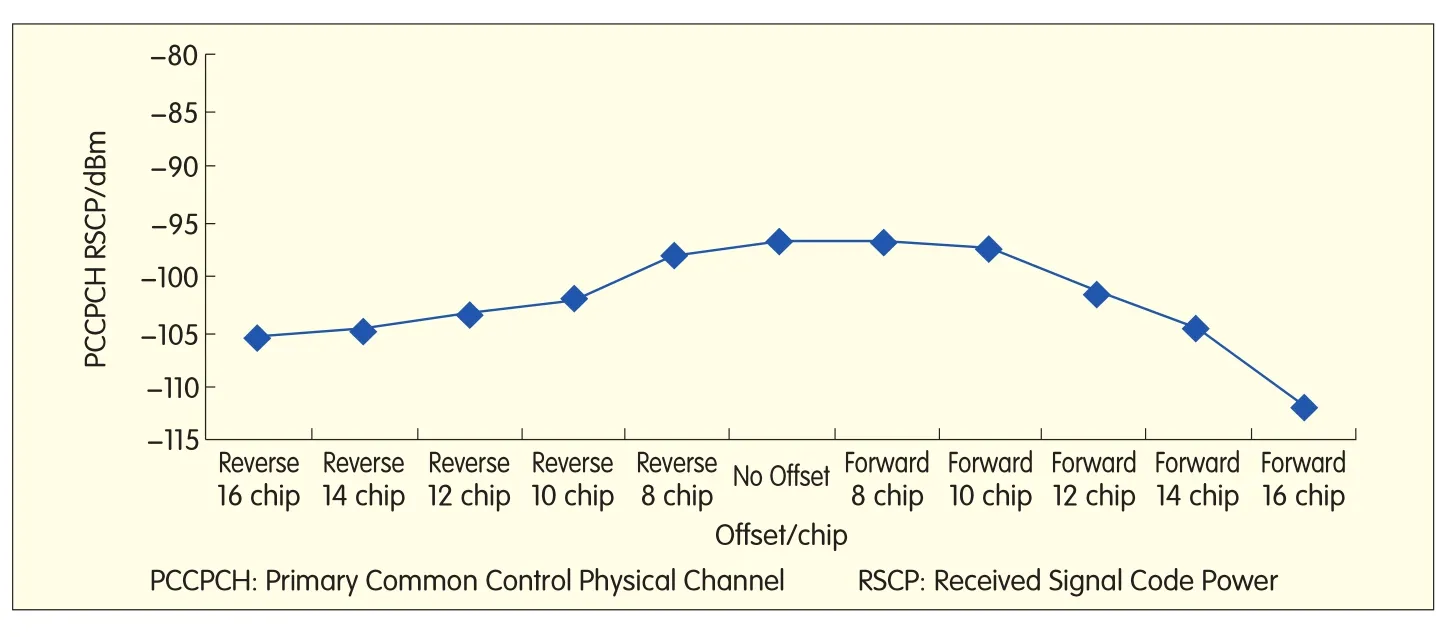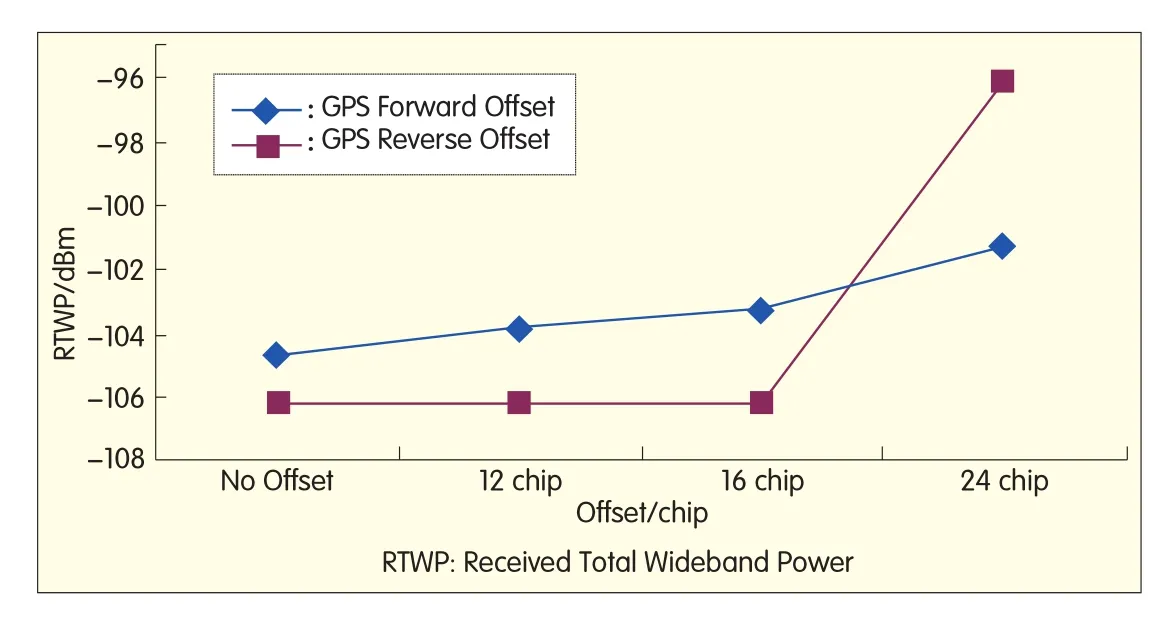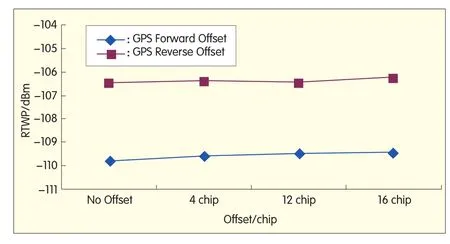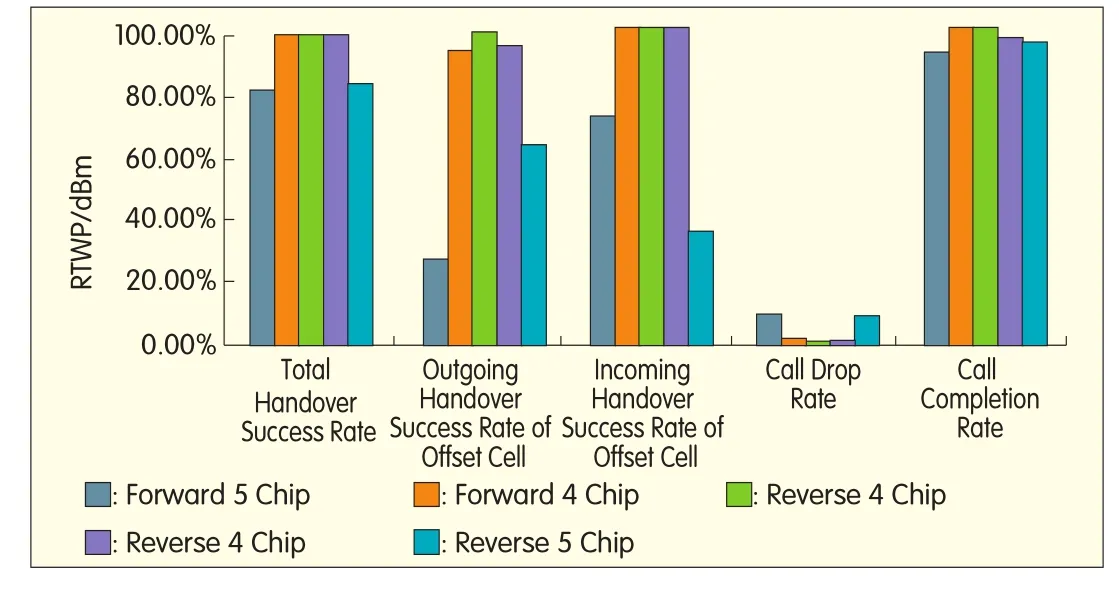Impacts of GPS Synchronization Loss on TD-SCDMA Network Performance
(ZTE Corporation,Shenzhen,518004,P.R.China)
Of the three 3G standards,CDMA2000 and Time Division Synchronous Code Division Multiple Access(TD-SCDMA)are both systems with synchronized base stations.The TD-SCDMA system is synchronized on a network-wide basis,and requires that all base stations be strictly synchronous.Handover and roaming functions between cells also require precise timing control.Synchronization is therefore a significant issue in TD-SCDMA communication systems.However,due to the lack of advanced network synchronization technology,TD-SCDMA base stations employ Global Positioning System(GPS)for synchronization purposes[1-14].In current TD-SCDMA networks,base stations sometimes fail to catch GPS satellite signals and lose synchronization for the following reasons:
(1)GPS signals experience interference from external signals
The working frequency of GPS is 1,575 MHz.The GPS signal,once transmitted from satellite to the ground,becomes very weak and is susceptible to outside interference.There are many factors that cause interference with a GPS signal;for example,interference from solar flares,interference from the ionized stratum and aerosphere environment,and interference from irregular weather conditions(such as lightening and thunderstorms).When interference occurs,the quality of the signals being received from the satellite is degraded—the Signal-to-Noise Rate(SNR)falls and the Bit Error Rate(BER)increases.There can even be cases where satellite signals cannot be received at all.
(2)Engineering construction
When a large number of sites are being set up,if the GPS antennas are installed where there are nearby obstacles,or if the quality of construction is less than perfect,problems such as high feeder impedance,feeder connector problems and water in the feeder cable can cause the received GPS signals to be quite weak.If synchronization is lost for an extended period of time,timing difference will occur between base stations.If this difference is too large,the Mobile Stations(MS)have problems searching neighboring cells,cell switchover is affected,Downlink Pilot Time Slot(DwPTS)interferes with Uplink Pilot Time Slot(UpPTS),and service timeslots overlap each other.All these problems affect network quality,giving rise to handover failures,call dropouts during handover,and a decline in call completion rates.As a consequence,user experience in the network is diminished.By testing how the timing difference between base stations(caused by synchronization loss)affects network performance,this paper concludes upon the degree of the timing difference that a TD-SCDMA system can tolerate.Thus,it serves as a reference when considering alternative GPS synchronization schemes.

Figure 1.Impact of GPS synchronization loss on neighboring cell measurement(or neighboring cell search).

Figure 2.Schematic diagram of DwPTS interference with UpPTS due to lost GPS synchronization.
1 Theoretical Analysis
GPS synchronization loss causes significant differences in GPS timing between base stations.From the perspective of TD-SCDMA frame structure,and the work mode of User End(UE)and system,it can be seen that synchronization loss impacts the system in three ways:
(1)Neighboring cell measurement(or neighboring cell search)during handover and cell reselection
The UE normally searches for neighboring cell DwPTS using the timing of the current cell DwPTS as a benchmark.If the timing difference with neighboring cells is too large,the UE will not search for the neighboring cell DwPTS in the DwPTS search window.Even if it can search for the neighboring cell,the Primary Common Control Physical Channel(PCCPCH)of the neighboring cell will have low-quality signals and low Signal-to-Interference Ratio(SIR).This will negatively effect the network’s Key Performance Index(KPI),resulting in the UE reselection and handover problems.Figure 1 shows the impact of GPS synchronization loss on neighboring cell measurement.
Because the relay handover in the TD-SCDMA system cuts short the UE UpPTS access process,it speeds up the handover process and brings about a higher handover success rate.However,this requires strict synchronization between the base stations.Once GPS synchronization is lost between base stations,and the UE fails to synchronize on the dedicated channel,the handover will fail.The UE sends special burst data on the dedicated channel,and the base station receives the data and gives confirmation.This process represents a successful uplink synchronization.When the base station sends special burst data and the UE receives it,successful downlink synchronization has occurred.
(2)Interference of DwPTS with UpPTS
As shown in Figure 2,to avoid DwPTS interfering with UpPTS between cells,the TD-SCDMA system has a 96-chip Grard Period(GP)timeslot between the two timeslots.In the event GPS synchronization is lost,the valid GP time between DwPTS and UpPTS becomes shorter.
An increase in UpPTS interference leads to a shrinking of UpPTS coverage,and this affects user uplink access at a cell’s border.(In a TD-SCDMA system,the circuit-switched domain 64k visible telephone service(CS64k)has the smallest coverage,and therefore the coverage of UpPTS traffic channel should be at least the same as that of CS64k.)In a real network,however,because a very small proportion of the area has PCCPCH Received Signal Code Power(RSCP)of less than-95 dBm,the influence on call completion rate is relatively low.
(3)Cross interference of service time slot
A 16-chip GP exists at the end of every time slot in the TD-CDMA system for uplink and downlink conversion,as shown in Figure 3.However,if the timing difference between cells is too great,cross interference of service time slots between cells will occur.
In the TD-SCDMA system,every service timeslot is 864 chips long.Therefore,cross interference caused by GPS synchronization loss affects some chips of the service timeslot.Obvious interference only occurs when GPS synchronization is lost to a large extent.
2 Test and Verification
To study the impact of GPS synchronization loss on network performance in a quantitative way,a verification test in a real network environment is performed.

Figure 3.Schematic diagram of cross interference of service time slot due to GPS synchronization loss.

Figure 4.Changes of neighbor cell PCCPCH_RSCP after GPS synchronization has been lost.
(1)Selection of Test Environment
A high site in a real network should be selected.Base station software for simulating GPS synchronization loss is then uploaded.This software can control and modify the timing difference caused by synchronization loss.The test conditions should also provide for one or two circles of base stations working with normal GPS synchronization,and with coverage extending to between 30 and 40 adjacent cells.
(2)Selection of Test Terminal
The Drive Test(DT)software is Pilot Navigator.The DT terminals are:two ZTE U85s,and one Datang 8120,which supports video phone.
(3)Simulation Uploading
Simulation uploading to the cell:75%simulation uploading;that is,uploading 75%code channel to a single timeslot with power of 27 dBm.
(4)Design of Test Examples
In total,eight test examples are designed.
(a)GPS timing forward difference of base stations
·Testing the ability of base station cells to search for neighboring cells when GPS synchronization has been lost.
·Testing UpPTS interference changes for base station cells when GPS synchronization has been lost.
·Testing service timeslot interference of cells that neighbor base station cells when GPS synchronization has been lost.
·Testing network performance KPI.
(b)GPS timing backward difference of base stations
·Testing the ability of base station cells to search for neighboring cells when GPS synchronization has been lost.
·Testing UpPTS interference changes for cells that neighbor base station cells when GPS synchronization has been lost.
·Testing service timeslot interference for base station cells when GPS synchronization has been lost.
·Testing network performance KPI.
3 Analysis of Test Results
3.1 Test Data of Base Station Ability
This analysis is concerned with neighboring cell search tests,and UpPTS interference changes for base station cells when GPS synchronization has been lost.A test point with PCCPCH_RSCP ranging from-65 to-75 dBm should be selected from the base station cells where GPS synchronization has been lost.A neighboring cell also needs to be selected for observation.Start the on/off function of the DT terminal five times and wait 2 mins every time it is on.Observe value changes of the neighboring cell’s PCCPCH_RSCP measured by the DT terminal,and then obtain the average value.The test results are shown in Figure 4.
(1)The neighboring cell’s PCCPCH_RSCP tends to shrink as the offset value grows,indicating an error made by the terminal in measuring the signal strength of the neighboring cell.This error will grow in proportion to the offset value.
(2)When the GPS forward offset is 12 chips or less,and the reverse offset is 10 chips or less,the neighboring cell’s PCCPCH_RSCP value changes by around 3dB compared with the value when there is no offset.Considering fluctuation of radio signals,such change is normal.
(3)Tests show that for the terminal not to be affected when searching for neighboring cells,the GPS forward offset must be 12 chips or less and the reverse offset 10 chips or less.That is,10 chips is the upper limit for synchronization loss of GPS base stations before the terminal’s ability to search for neighboring cells is affected.
3.2 Test Data of UpPTS Interference Changes
This analysis is concerned with UpPTS interference change for both base station cells and neighboring cells when GPS synchronization has been lost.When the forward offset of a base station with GPS synchronization loss is out of step,the DwPTS of base station cells other than those with the GPS synchronization loss interfere with the UpPTS of the base station with the GPS synchronization loss.When the reverse offset of a base station with GPS synchronization loss is out of step,the DwPTS of base station cells with synchronization loss interfere with the UpPTS of base stations other than those with GPS synchronization loss.This interference relationship is shown in Figure 5.
To ensure the UpPTS timeslot has the same coverage as that of a CS64k service,the interference surplus of UpPTS is 3 dB according to the link estimation.That is,when the UpPTS timeslot rise exceeds-103.3 dBm(-103.3 dBm=-106.3 dBm+3 dBm),the coverage of a UpPTS timeslot will become smaller than that of CS64k service.This is contrary to the TD-SCDMA network plan rules.From these tests,it can be concluded from that when the GPS offset is smaller than 16 chips,the UpPTS interference is below-103.3 dBm,the offset exceeds 16 chips,and the interference grows further.This is also contrary to the network plan rules.The tests show that 16 chips of GPS offset is the upper limit of interference that UpPTS can experience before the network plan rules are breached.

Figure 5.RTWP changes of UpPTS time slot with interference after GPS synchronization is lost.

Figure 6.RTWP changes of uplink time slot 2 with interference after GPS synchronization is lost.

Figure 7.Network KPI after GPS synchronization is lost.
3.3 Test Data of Service Timeslot Interference
This analysis is concerned with service timeslot interference for both base station cells and neighboring cells when GPS synchronization has been lost.In this test,the service timeslot of the cells is configured as 2:4(2 uplink timeslots are Timeslot 1 and Timeslot 2;4 downlink timeslots are Timeslot 3,Timeslot 4,Timeslot 5,and Timeslot 6).When the forward offest of a base station with GPS synchronization loss is out of step,downlink Timeslot 3 of base station cells with synchronization loss interferes with uplink Timeslot 2 of base station cells without GPS synchronization loss.When the reverse offset of a base station with GPS synchronization loss is out of step,downlink Timeslot 3 of base station cells without GPS synchronization loss interfere with uplink Timeslot 2 of the base station cells with GPS synchronization loss.In the test,75%code channel is created for interference Timeslot 3,and 27 dBm power is uploaded to simulate the service traffic in a real network environment.In these conditions,a dial test of service CS12.2k(circuit switched domain)is performed on the uplink Timeslot 2 with interference,and the RTWP value of uplink Timeslot 2 with interference is recorded.Figure 6 shows the value changes.
The test shows that the call completion rate of CS12.2k is 100%,and the RTWP of uplink Timeslot 2 with interference does not increase significantly.
3.4 Test Data of Network Performance KPI
This analysis is concerned with the network performance KPI.The network KPI test is carried out for the CS12.2k service in a real network.Test details are:two terminals(handsets);the CS12.2k call is held for 2 mins;the hang-up interval is 15 seconds;attempts to initiate calls is 50 times or more,and the attempts of handover is 100 times or more.Figure 7 shows the test result.
(1)As the GPS offset value increases,the handover success rate and call completion rate fall,and the call dropout rate rises.These all have negative effects on network KPI.
(2)The handover success rate is more than 98%when the GPS offset remains no more than 4 chips.This is necessary to keep the network KPI normal.
(3)When the GPS offset is more than 5 chips,the handover success rate and call completion rate fall,and the call dropout rate rises significantly.
(4)GPS offset drives down the terminal’s reselection efficiency,and results in a decrease in call completion rate.
4 Conclusions
From the above tests,it can be concluded that:
(1)Compared with the terminal’s neighboring cell measurement(search),UpPTS time slot interference,and service time slot cross interference,network KPI is most affected by GPS synchronization loss.The maximum allowable offset value for synchronization loss in a terminal’s neighboring cell measurement(search)is 10 chips(12 chips and 10 chips,the lower value is taken).The maximum allowable offset value for synchronization loss in UpPTS time slot interference is 16 chips.No rise in interference is found for service timeslot interference in the above conditions of synchronization loss.The maximum allowable offset value for synchronization loss in network KPI is 4 chips.
(2)3GPP Specifications 25.123[15]state that a base station requires synchronization within 3 μs.Tests show that 4 chips(3.125 μs)is the maximum allowable value for inter base station synchronization loss.The test results are therfore consistent with these specifications.
(3)At present,synchronization of TD-SCDMA systems is totally dependent on the GPS of the United States.This can translate into security concerns.China’s CDMA network has already broken down once due to a GPS authorization problem.For this reason,it is very important for TD-SCDMA to find an alternative synchronization system.This paper presents the precision requirements for any new synchronization scheme.
[1]HOLMA H,TOSKALA A.HSDPA/HSUPA技術(shù)與系統(tǒng)設(shè)計(jì):第三代移動(dòng)通信系統(tǒng)寬帶無線接入[M].葉銀法,陸健賢,周勝,等譯.北京:機(jī)械工業(yè)出版社,2007.
HOLMA H,TOSKALA A.HSDPA/HSUPA for UMTS:High Speed Radio Access for Mobile Communications[M].Translated by Ye Yinfa,Lu Jianxian,Zhou Sheng,et al.Beijing:China Machine Press,2007.
[2]常永宇.TD-HSPA移動(dòng)通信技術(shù)[M].北京:人民郵電出版社,2008.
CHANG Yongyu.TD-HSPA Technology for Mobile Communications[M].Beijing:Posts and Telecommunications Press,2008.
[3]彭木根,王文博.TD-SCDMA移動(dòng)通信系統(tǒng)—增強(qiáng)和演進(jìn)[M].北京:機(jī)械工業(yè)出版社,2008.
PENG Mugen,WANG Wenbo.TD-SCDMA Mobile Communication System—Enhancement and Evolution[M].Beijing:China Machine Press,2008.
[4]彭木根,王文博.TD-SCDMA移動(dòng)通信系統(tǒng)[M].2版.北京:機(jī)械工業(yè)出版社,2007.
PENG Mugen,WANG Wenbo.TD-SCDMA Mobile Communication System—Enhancement and Evolution[M].Edition 2.Beijing:China Machine Press,2007.
[5]謝顯中.TD-SCDMA第三代移動(dòng)通信系統(tǒng)技術(shù)與實(shí)現(xiàn)[M].北京:電子工業(yè)出版社,2004.
XIE Xianzhong.Technology and Implementation of TD-SCDMA Mobile Communication System[M].Beijing:Publishing House of Electronics Industry,2004.
[6]李世鶴.TD-SCDMA第三代移動(dòng)通信系統(tǒng)標(biāo)準(zhǔn)[M].北京:人民郵電出版社,2004.
LI Shihe.Standards for TD-SCDMA Mobile Communication System[M].Beijing:Posts and Telecommunications Press,2004.
[7]段玉宏,夏國忠,胡劍,等.TD-SCDMA無線網(wǎng)絡(luò)設(shè)計(jì)與規(guī)劃[M].北京:人民郵電出版社,2007.
DUAN Yuhong,XIA Guozhong,HU Jian,et al.TD-SCDMA Wireless Network Design and Planning[M].Beijing:Posts and Telecommunications Press,2007.
[8]朱東照,羅建迪,汪丁鼎,等.TD-SCDMA無線網(wǎng)絡(luò)規(guī)劃設(shè)計(jì)與優(yōu)化[M].2版.北京:人民郵電出版社,2008.
ZHU Dongzhao,LUO Jiandi,WANG Dingding,et al.TD-SCDMA Wireless Network Planning and Optimization[M].Edition 2.Beijing:Posts and Telecommunications Press,2008.
[9]張傳福,彭燦,李巧玲,等.TD-SCDMA通信網(wǎng)絡(luò)規(guī)劃與設(shè)計(jì)[M].北京:人民郵電出版社,2009.
ZHANG Chuanfu,PENG Can,LI Qiaoling,et al.TD-SCDMA Communication Network Planning and Design[M].Beijing:Posts and Telecommunications Press,2009.
[10]ZHU Jinkang.Wireless Mesh Technology and Network[J].ZTE Communications,2008,6(2):1-4.[11]WU Meng,JI Lina,WANG Kun.Key Technologies of Wireless Heterogeneous Network Security[J].ZTE Communications,2008,6(3):34-39.
[12]呂應(yīng)權(quán),周沖.WCDMA系統(tǒng)有效提高切換成功率的方法[J].中興通訊技術(shù),2008,14(4):56-60.
Lü Yingquan,ZHOU Chong.A Valid Way to Improve the Success Ratio of Switching in WCDMA Systems[J].ZTE Communications,2008,14(4):56-60.
[13]糜正琨.移動(dòng)IP技術(shù)[J].中興通訊技術(shù),2008,14(4):59-62.
MI Zhengkun.Mobile IP technology[J].ZTE Communications,2008,14(4):59-62.
[14]闞凱力.無線城市的運(yùn)行模式[J].中興通訊技術(shù),2008,14(6):50-52.
KAN Kaili.Business Model of the Wireless City[J].ZTE Communications,2008,14(6):50-52.
[15]3GPP TS 25.123 V6.11.0.3rd Generation Partnership Project:Technical Specification Group Radio Access Network:Requirements for Support of Radio Resource Management(TDD)(Release 4)[S].2007.

